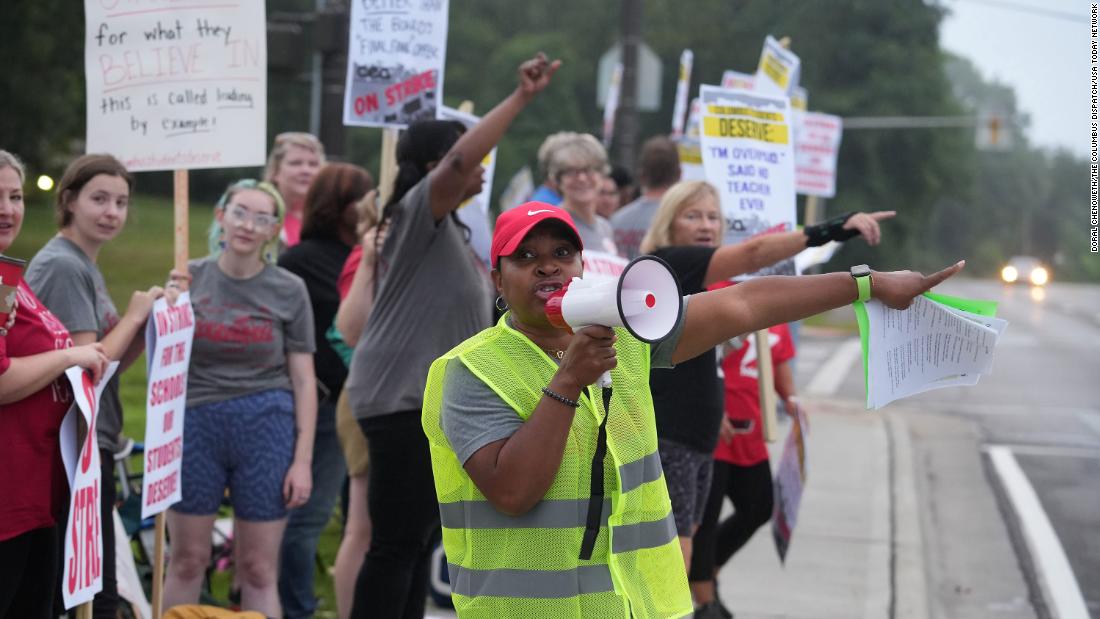
In Philadelphia, it’s mostly bus drivers and other workers who want better wages and training.
These are local stories with distinct issues and details, but they feed a national narrative of discontented teachers and support staff who feel underpaid and underappreciated.
What’s happening in Columbus
Rather than report to school, students may have to relive the pandemic and log in for remote learning Wednesday, the first day of school, according to the district’s current plan.
It’s about air conditioning, not economics
The union has said the sticking points are about learning conditions and it wants the district to guarantee smaller class sizes, more specialized teachers for art, music and physical education in elementary school, “functional heating and air-conditioning in classrooms,” more prep time and a cap on the number of class periods during the school day, according to a statement from the union.
Appearing on CNN from Columbus on Monday, Columbus Education Association member and library media specialist Courtney Johnson talked about the strike and argued the teachers are focused on working conditions, not economics.
“Our Columbus City School students deserve a commitment to modern schools with properly working heating and air conditioning and smaller class sizes, and art, music and PE,” she said. “CEA has never made this about economics.”
She said schools there have been forced to close in the past when air conditioning failed, and students in the high school where she works move from hot rooms to cold rooms.
“You can imagine how hard it is to learn in a classroom that’s freezing cold or very hot,” she said.
The school board wants to ask voters for more money. The union wants the board to use federal money.
Pay is also an issue
It’s not clear from the recent reporting where the pay disagreement between the board and the union landed.
Teachers pay a ‘wage penalty’
The Economic Policy Institute used government data to argue that average weekly wages for teachers, when adjusted for inflation, increased about $29 in the 25 years between 1996 and 2021.
While teachers do get non-salary compensation, like time off in the summer and health and retirement benefits, they are still paying a “wage penalty” compared with other college-educated workers, according to EPI.
The year stolen from kids
As I was considering the idea of Columbus kids again navigating remote learning, I got sucked into the interview CNN’s Sara Sidner had with Anya Kamenetz, an NPR reporter and author of “The Stolen Year,” a new book focused on how the pandemic affected American children.
I was interested in the following excerpts from their conversation that aired on CNN International.
What was stolen in ‘The Stolen Year’?
KAMENETZ: The United States is a wealthy country full of poor children. More than half the children in public schools are considered low income. When schools closed, many of those children lost meals that they depended on, a safe place to be during the day and mental health services, as well as academics and socialization.
So what I document in “The Stolen Year” is how these changes really wreaked havoc on children starting in the first few weeks.
It will take years to get back on track
KAMENETZ: The most recent numbers in July of 2020 suggest that it’s going to take about three years for the average elementary school student to be where they were on an academic trajectory.
Obviously that doesn’t capture what we’re talking about as far as mental health, as far as trauma.
Middle school students, in the last school year, have not started to make academic recovery. So they’re going to be even longer. I’m also really concerned about the kids who drifted from high school into paid work. Many of them, we see that college-going has really gone down, specifically in the United States.
We are worried about their long-term economic and educational outcomes from no longer being engaged with school in the same way.
Teachers feeling targeted
And I’ve talked to those school leaders who said, “All I ever wanted to do is help take care of the kids and now everybody is targeting me.”
The pandemic was harder on many mothers
KAMENETZ: I argue it based on the research. I argue it to some extent based on my experience as the mom of two young girls.
My family tried to divide things up equally, but inevitably — well, I won’t say it’s inevitable — what happened in this country is that we allowed mothers to cut back on their working hours, become stressed, start drinking, gain weight, express depression, anxiety, insomnia, and we allowed them to continue picking up more and more of the slack at home and with remote schooling.
Statistically, generally speaking, heterosexual partners who were men didn’t step up. They didn’t do their part; they didn’t step back from the workforce in the same way that women did.

